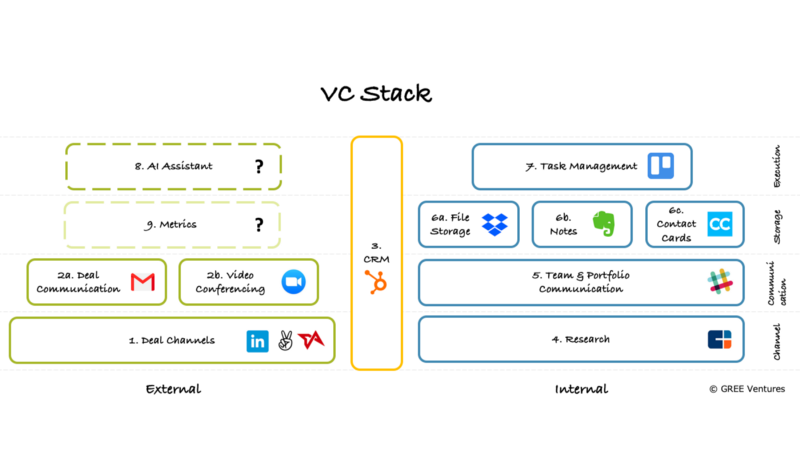Our updated VC stack
And what’s to come in 2020

And what’s to come in 2020
One of the key differentiators I feel my team has as a VC is our background in technology and startups. It allows us to work and behave like a nimble startup ourselves, using multiple SaaS tools internally just like any of you do.
Last year I published this post talking about a basic VC stack that we started adopting internally. I thought it was a good time to revisit the stack and review the changes we have made.
The Updates
We adopted two tools internally in 2018. Hubspot and Zoom.
Hubspot has been great in reducing our manual processes every day. It is especially helpful during our weekly sync-ups. I can do a detailed post around our usage of Hubspot as a VC some other time, but the most crucial aspect for me are the dashboards. It helps me track how the team is performing in terms of sourcing and pipeline processing every week, a key indicator of how good we are doing as a team. However, if I have one complaint around Hubspot, it’s the lack of a proper iOS app. The current app is awful and clunky, addition of contacts, companies, and deals especially is a painful task. I hope the Hubspot team fixes the app so that we can process our pipeline on-the-go.
Zoom, meanwhile has been a god-send. We were using a mix of Google Hangouts/Appear/Skype earlier, but switched to Zoom mid-year. The call quality has been flawless including in emerging markets, the platform works well with dial-in as well as web, the mobile app is seamless, and the call scheduling extension for Chrome is extremely nifty. No wonder the company has had such a successful IPO.
The New
As you can see we mostly strengthened the existing VC tech stack for ourselves last year. It was a great year for setting a fundamental base in place. This year, we are mulling two exciting new projects:
8. AI Assistant
It’s a bit ironic that the VCs who talk about investing in AI are themselves using data spreadsheets and manual processes for their own work. AI is here to disrupt us all, including VCs. And as a result we have started thinking of how to leverage it internally. We have some nifty tricks up-our-sleeves, and if things work as we want them to, this can be a great competitive (most likely, temporary though) edge for us. I expect some part of the AI assistant to be rolled-out this year itself.
9. Metrics
This is one idea we have been toying around for some time now. Every month one of our Analysts reaches out to each of our portfolio companies with a spreadsheet template to fill up the previous month’s KPIs. It usually takes the startup 2–3 days to finish (some times more) and send the updated spreadsheet. We then go ahead and compile all this data into a master spreadsheet, as well as create a report for our LPs based on the new data received. This is a cumbersome process and takes overall a week every month. We have been looking to automate parts of this journey, but there are a few concerns because of which we haven’t moved the process to the cloud yet:
a) Ease: It’s easier for the startups to fill out an Excel spreadsheet quickly while maintaining proper formatting
b) Security: The data is highly confidential for the startups and hence private spreadsheets are less likely to get hacked
c) Mutability: It’s fairly easy to change previous month’s data while fixing errors, or to change the focus KPI that we should be tracking. This will usually take more time on another platform
But the effort required on our end to combine the sheets, verify the cleanliness of data, and maintain sanctity of the document is a bit too much currently. We’ll try to find a solution for this within the year. If you faced a similar problem and fixed it for yourself then please throw some tips my way in the comments section.
For the VCs amongst the readers, what’s your stack?
